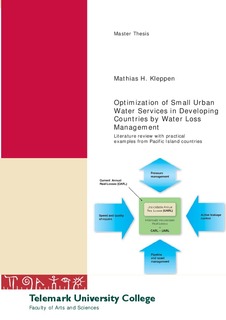Optimization of Small Urban Water Services in Developing Countries by Water Loss Management. Literature review with practical examples from Pacific Island countries
| dc.contributor.author | Kleppen, Mathias H. | |
| dc.date.accessioned | 2011-07-22T02:27:46Z | |
| dc.date.accessioned | 2017-04-19T13:13:47Z | |
| dc.date.available | 2011-07-22T02:27:46Z | |
| dc.date.available | 2017-04-19T13:13:47Z | |
| dc.date.issued | 2011 | |
| dc.identifier.uri | http://hdl.handle.net/11250/2438924 | |
| dc.description.abstract | Water is by far our most important natural resource needed to sustain all forms of life on our planet. Today we face depletion and increased scarcity of this precious resource. At the same time there is also a rapid urbanization process going on, - in particular in developing nations. This will put an unprecedented pressure upon the urban water service providers (water utilities) to supply enough hygienically safe water for their customers. Small Island Developing States (SIDS) are no exception to this general trend. Water losses occur to different degrees in all water supply systems. In developing countries it is not uncommon that half of the water invested in through production and distribution is lost through different types of wastage. There is however methods and techniques that can be applied to reduce the waste of drinking water. This thesis analyses, through an extensive literature review, some of the methods applied on the demand side. As opposed to supply side management that concentrates on major infrastructural investments, the demand side management develops strategies to improve and optimize existing water resources and infrastructure. The term for these strategies applied to Pacific water service providers are Water Loss Management (WLM). WLM could potentially contribute significantly to meet the millennium development goal 7 (specifically target 7c) for the given country. WLM strategies are known to be data intensive, but many service providers in SIDS do not have an adequate set of data to give a reasonable idea of “what water goes where”. The goal of this research is to find ways to optimize water supply in small urban services in Pacific Island Countries (PIC). It is believed that the most crucial step, from having very little overview to having an improved overview on the supply system, is achievable by starting up WLM initiatives whilst data needs are identified and strategies are implemented to deliver these needs. Based on the literature review WLM initiatives were implemented and are presented as three different practical examples. Field observations and analysis of the examples emphasizes the understanding of the baseline situation as a critical first step in moving towards an effective WLM program. Suggested strategies and the identification of key factors that influence the implementation of WLM initiatives in PIC are explained. | |
| dc.language.iso | eng | |
| dc.publisher | Høgskolen i Telemark | |
| dc.subject | water loss management | |
| dc.subject | non-revenue water | |
| dc.subject | small island developing states | |
| dc.subject | urban water services | |
| dc.title | Optimization of Small Urban Water Services in Developing Countries by Water Loss Management. Literature review with practical examples from Pacific Island countries | |
| dc.type | Master thesis | |
| dc.description.version | Published version | |
| dc.rights.holder | © Copyright The Author. All rights reserved | |
| dc.subject.nsi | 467 |
